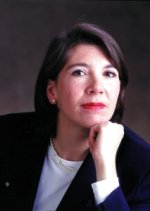
UP FRONT
Lifeguards at the Gene Pool
by Anne Palmer Peterson, Editor
 Like a lot of people, I've been wondering whether we've gone too
far or not far enough with genetic testing. When I think about some of
my closest friends, all under 40, who have had life-threatening conditions
plausibly related to the genes they inherited, I can't help pondering
the implications of the genetic advances underway at the U. Sarah, who
is both a newlywed and a competitive athlete, discovered a cancerous lump
in her breast, and so underwent a mastectomy and chemotherapy this year.
A colleague at work, also younger than I, is cautiously preparing, with
her sister, for counseling at the Huntsman Cancer Institute. It will help
them decide whether to undergo testing for one of two identified breast
cancer genes. They have two aunts with breast cancer. Their grandmother
had it, too, before she died. They are looking to the High Risk Breast
Cancer Clinic to illuminate the history of cancer in their family, as
well as to clarify their own specific risks.
Like a lot of people, I've been wondering whether we've gone too
far or not far enough with genetic testing. When I think about some of
my closest friends, all under 40, who have had life-threatening conditions
plausibly related to the genes they inherited, I can't help pondering
the implications of the genetic advances underway at the U. Sarah, who
is both a newlywed and a competitive athlete, discovered a cancerous lump
in her breast, and so underwent a mastectomy and chemotherapy this year.
A colleague at work, also younger than I, is cautiously preparing, with
her sister, for counseling at the Huntsman Cancer Institute. It will help
them decide whether to undergo testing for one of two identified breast
cancer genes. They have two aunts with breast cancer. Their grandmother
had it, too, before she died. They are looking to the High Risk Breast
Cancer Clinic to illuminate the history of cancer in their family, as
well as to clarify their own specific risks.
It has been nine years since another friend borrowed my medical encyclopedia so that he could look up spina bifida. Reading it, he began to cry, confiding that his unborn son had inherited the congenital defect. He and his wife already had one mildly affected child and had been counseled at the U about the risks of having another affected child. So they made preparations for a high-risk delivery and the first of many surgeries their son would undergo--beginning on his birth day.
With the rapid pace at which genetic technology is evolving, more and more people are facing personal dilemmas associated with testing. Ten years ago, virtually all genetic testing was in prenatal obstetrics and pediatrics. Today, more than 15 percent of genetic counselors are focused on cancer patients. Experts predict that the next specialty and subspecialty areas where testing and counseling will prevail are neurogenetic and psychiatric disorders, as well as cardiology. We need more help to understand better the ethical, legal, and social implications.
There are many reasons for intense interest in various aspects of genetic testing. For Representative Nora Stephens, sponsor of a Genetic Testing Privacy Act likely to be introduced in the 1999 Utah Legislature, the value of genetic information has created a need for state governments to help protect the privacy of tested individuals. For Distinguished Professor of Biology and Human Genetics Mario Capecchi, featured in our cover story, new gone targeting capabilities bring to the fore a pressing need for research scientists to communicate more effectively what they are trying to achieve. To Distinguished Professor of Human Genetics Ray Gesteland, it is so essential to take the mystery out of DNA testing that during a recent discussion he invited audience members to take a swab of their own inner cheek cells, and from those confidential samples, take a peek at their own genetic fingerprints. It helped underscore his point that the technology to produce such results could be transported in the trunk of a car and installed temporarily in the Marriott Library.
Lately, we've been reading that genetics may play a greater role than do lifestyle factors in determining certain health risks. There are plenty of reasons for a healthy dose of anxiety to accompany that news. Protections for medical privacy are needed so that people who might undergo genetic testing aren't penalized. Without the ability to ensure privacy, geneticists may not have access to the sources of the information they need--people like you and me.
In this issue, Continuum not only explores genetic discoveries at the U and how they affect our lives, it also notes with tremendous remorse the death of one of the University's acclaimed pioneers in genetics and heart disease. Dr. Roger R. Williams, 54, a cardiovascular geneticist and professor of internal medicine at the School of Medicine, died in the crash of SwissAir Flight SR111 off the coast of Nova Scotia. For more than a decade, he helped to raise awareness of heart disease risk factors through Utah high school health classes, where students charted the incidence of serious illnesses as part of the Utah Family Tree project. I like to think that it also encouraged some teenagers to pursue careers in gene science.
Dr. Williams frequently traveled to promote another massive public health project that combines new discoveries in genetics with computerized genealogical tools. Participants in 38 countries are seeking to help people with an inherited susceptibility to high serum cholesterol levels that can cause early heart disease and heart attacks. Dr. Williams was on his way to Geneva to discuss the project with the World Health Organization when his plane went down. Our families are indebted to him for his work.
Copyright 1999 by The University of Utah Alumni Association